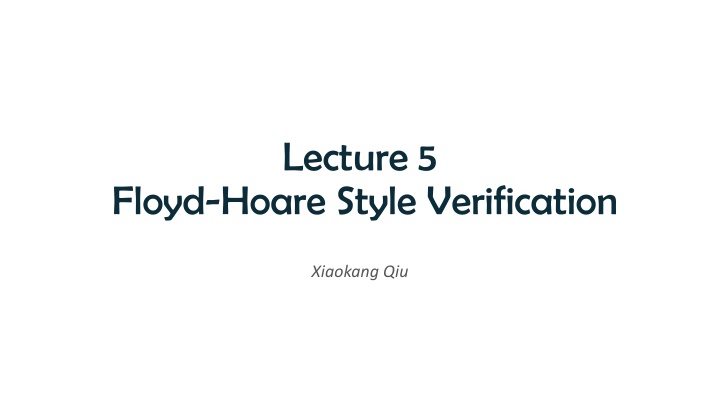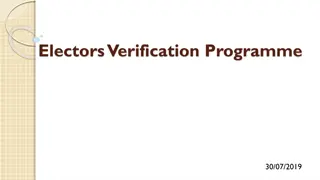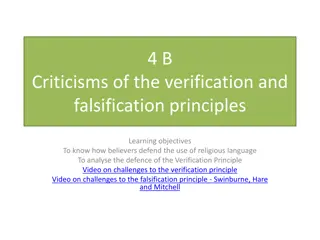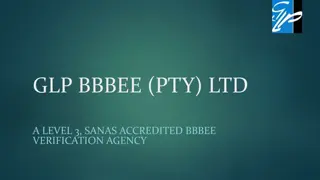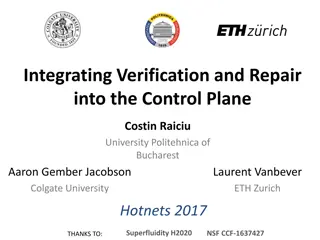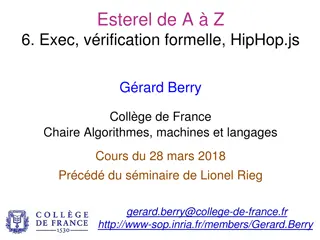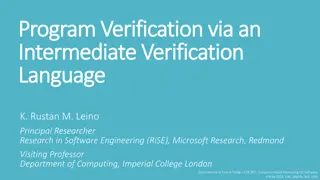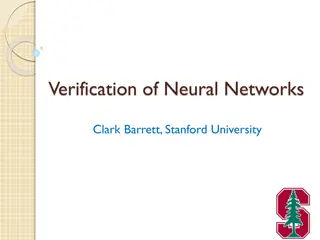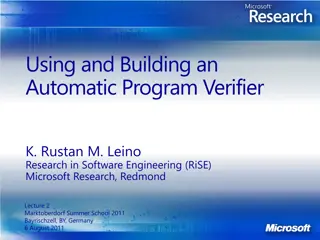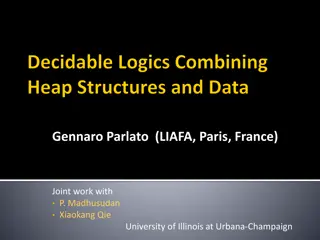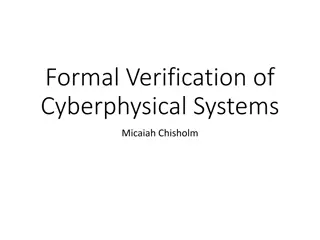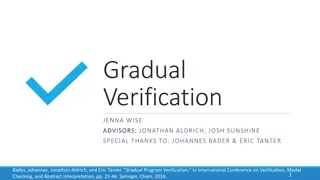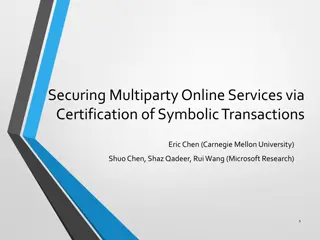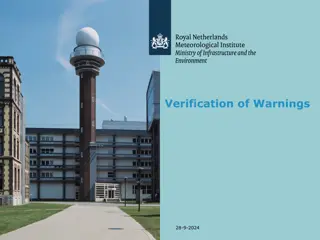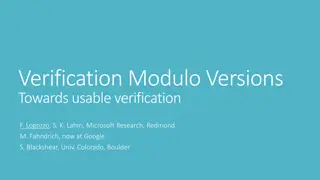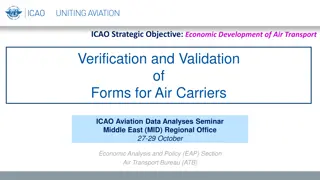A New Approach to Program Verification
The Floyd-Hoare style of program verification, this content delves into axiomatic semantics, historical perspectives, and the basics of Hoare triples in software correctness. Dive into the world of program logics and assertions to enhance your understanding.
Download Presentation

Please find below an Image/Link to download the presentation.
The content on the website is provided AS IS for your information and personal use only. It may not be sold, licensed, or shared on other websites without obtaining consent from the author.If you encounter any issues during the download, it is possible that the publisher has removed the file from their server.
You are allowed to download the files provided on this website for personal or commercial use, subject to the condition that they are used lawfully. All files are the property of their respective owners.
The content on the website is provided AS IS for your information and personal use only. It may not be sold, licensed, or shared on other websites without obtaining consent from the author.
E N D
Presentation Transcript
Lecture 5 Floyd-Hoare Style Verification Xiaokang Qiu
Motivation o Consider the following program: z = 0; i = x; while (i) { } z = z + y; i = i 1; 2
Motivation o The techniques we learned in 573 are insufficient. - Easy to argue that a given input will produce a given output. - Easy to argue that a property always holds at a single program point - Also easy to argue that all constructs in the language will preserve some property (like when we proved type soundness). - Much harder to prove general properties of the behavior of a program on all inputs. 3
Axiomatic Semantics (AKA program logics) o A system for proving properties about programs o Key idea: - We can define the semantics of a construct by describing its effect on assertions about the program state. o Two components - A language for stating assertions ( the assertion logic ) - Can be First-Order Logic (FOL), a specialized logic such as separation logic, or Higher-Order Logic (HOL), which can encode the others. - Many specialized languages developed over the years: Z, Larch, JML, Spec# - Deductive rules ( the program logic ) for establishing the truth of such assertions 4
A little history o Early years: Unbridled optimism - Heavily endorsed by the likes of Hoare and Dijkstra - If you can prove programs correct, bugs will be a thing of the past. - You won t even have to test your programs! o The middle ages - 1979 paper by DeMillo, Lipton and Perlis - Proofs in math only work because there is a social process in place to get people to argue them and internalize them. - Program proofs are too boring for social process to form around them. - Programs change too fast and proofs are too brittle. o The renaissance - New generation of automated reasoning tools - A handful of success stories - Better appreciation of costs, benefits and limitations? 5
The basics {A} stmt {B} Precondition Postcondition o Hoare triple - If the precondition holds before stmt and stmt terminates, postcondition will hold afterward. o This is a partial correctness assertion. - We sometimes use the notation [A] stmt [B] to denote a total correctness assertion which means you also have to prove termination. 6
What do assertions mean? o We first need to introduce a language. o For today we will be using Winskel s IMP: e := n | x | e1 + e2 | e1 - e2 o c:= x := e | c1; c2 | if e then c1 else c2 | while e do c o Big Step Semantics have two kinds of judgments: expressions result in values; commands change the state 7
Semantics of IMP o Commands mutate the state: o What about loops? 8
Semantics of IMP o The definition for loops must be recursive. 9
What do assertions mean? o The language of assertions: - A := true | false | e1 = e2 | e1 e2 | A1 A2 | A | x. A o Notation ? ? means that the assertion holds on state ? . - ? is interpreted inductively over state ? as a FO structure. - Ex. ? ? ? iff. ? ? and ? ? o Partial Correctness can then be defined in terms of OS: o {A} c {B} iff. o If the program state before execution satisfies A, and the execution of c terminates, the program state after execution satisfies B 10
Defining axiomatic semantics o Establishing the truth of a Hoare triple in terms of the operational semantics is impractical. o The real power of AS is the ability to establish the validity of a Hoare triple by using deduction rules. - means we can deduce the triple from a set of basic axioms. 11
Derivation Rules o Derivation rules for each language construct o Can be combined together with the rule of consequence 12
Example The following program purports to compute the square of a given integer n (not necessarily positive). int i, j; i := 1; j := 1; while (j != n) { i := i + 2*j + 1; j := j+1; } return i;
Example {true} int i, j; i := 1; j := 1; while (j != n) { i := i + 2*j + 1; j := j+1; } return i; {i = n*n}
Example {true} int i, j; {??} i := 1; {??} j := 1; {??} while (j != n) { i := i + 2*j + 1; j := j+1; } {??} return i; {i = n*n}
Example {true} int i, j; {true} //strongest postcondition i := 1; {i=1} //strongest postcondition j := 1; {i=1 j=1} //strongest postcondition {??} //loop invariant while (j != n) { i := i + 2*j + 1; j := j+1; } {i = n*n} //weakest postcondition return i; {i = n*n}
Example {true} int i, j; {true} //strongest postcondition i := 1; {i=1} //strongest postcondition j := 1; {i=1 j=1} //strongest postcondition {i = j*j} //loop invariant while (j != n) { i := i + 2*j + 1; j := j+1; } {i = n*n} //weakest postcondition return i; {i = n*n}
Example {true} int i, j; {true} //strongest postcondition i := 1; {i=1} //strongest postcondition j := 1; {i=1 j=1} //strongest postcondition {i = j*j} //loop invariant while (j != n) { {i = j*j j != n} i := i + 2*j + 1; {i = (j+1)*(j+1) j != n} j := j+1; {i = j*j j-1 != n} } {i = n*n} //weakest postcondition return i; {i = n*n}
Soundness and Completeness o What does it mean for our deduction rules to be sound? o What does it mean for them to be complete? o So are they complete? {true} x:=x {p} {true} c {false} o o o Relative Completeness in the sense of Cook (1974) Expressible enough to express intermediate assertions, e.g., loop invariants o 19
Total Correctness o Definition: a well-ordered set is a set ? with with a total order > such that every non-empty subset of ? has a least element. o E.g., ,> is a w.o. set, ,>is not 2,> where ?,? > ? ,? if ? > ? , or ? = ? and ? > ? o 20
Total Correctness o Termination: o 1. find a ranking function ????:?????????? ( ,>) o 2. find a set cutpoints (program points) to cut the program o 3. prove for any cutpoint ??, and any two program states ?1,?2, if (?1,??) reaches (?2,??) in a execution sequence, then ???? ?1 > ????(?2) o Example: while (x>5) x:=x-1; 21
Total Correctness Example: int i, j; i := 1; j := 1; while (j != n) { i := i + 2*j + 1; j := j+1; } return i; 22
